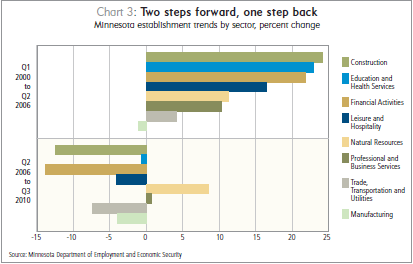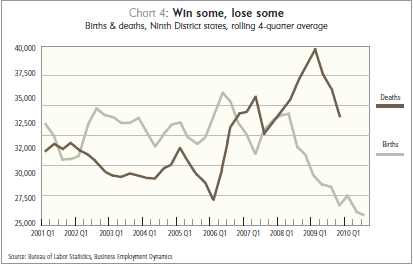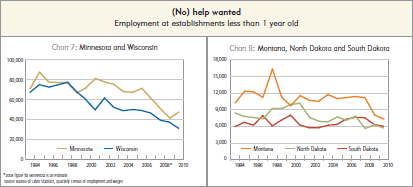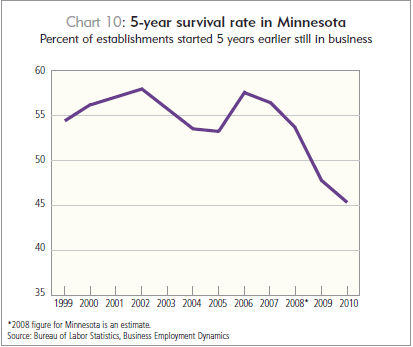Abstract
It’s common knowledge that the recession has been tough on businesses. But society has a comparatively tenuous understanding of business organization trends—particularly young establishments that play a critical role in economic and employment growth—because data are not as comprehensive or timely. Better data are becoming available from the Bureau of Labor Statistics, and they show that total establishments fell notably across most district states and industry sectors, but have recently started to rebound. The data also suggest some troubling trends among new establishments in Ninth District states, including a lower birth rate, dropping employment and a shrinking life span. Some of these trends started before the recession.

Woe is the small business owner in today’s economy. As if competing with large corporate firms weren’t enough, the recession and slow recovery have sliced the margin of error—and profit—for small businesses even thinner.
Dan Anderson is the director of the Small Business Development Center (SBDC) in Helena, Mont., and full or part owner in a preschool, an auto repair shop, a health care company, a technology-based construction company and a commercial real estate firm. As both business consultant and owner, “I can tell you it’s always tough for small businesses,” he said. Over the past 23 years, “I have seen difficult conditions, but nothing like what we have seen since 2008.”
Just don’t expect a lot of sympathy if you’re a business owner. In response to a fedgazette survey, the owner of a small business consulting firm in the Twin Cities said that “unfortunately, the small business owner is perceived by the average employed individual as ‘one of them’—spoiled, unfairly supported and given favored treatment by the government.” A restaurant owner in suburban St. Paul, Minn., noted that “a lot of people think that if you have a business, you’re counting hundred dollar bills in the back office.”
As a result, society also tends to pay business failure much less attention than it does unemployment, which is obsessively tracked, reported and followed. Don’t believe it? How long has it been—how many hours have passed—since you last heard a report about unemployment?
In contrast, when’s the last time you heard about trends in the number of businesses or newly created firms or establishments that closed their doors? Yes, you’ve heard anecdotes and know intuitively that businesses are hurt by recessions. But you probably know much more about the nuances of the job market than about the businesses that create the job market. And when jobs are like golden eggs, wouldn’t you like to know a little more about the goose?
Long-term trends regarding business formation, destruction and overall success have immense ramifications for the economy, but data are not particularly timely or robust, especially compared to their unemployed cousin. The data are getting better, however, and they show that the recession took a significant bite out of the total number of Ninth District businesses, but that their numbers might finally be on the upswing.
Recent research also suggests that some well-worn beliefs about business could use updating. For example, it’s widely held that small firms are the nation’s economic driver. But job growth is driven disproportionately by young firms, rather than by small firms per se. As a Kauffman Foundation report last summer stated: “Startups aren’t everything when it comes to job growth. They’re the only thing.”
If that is indeed the case, there are some notable trends among new establishments worthy of attention, including a lower birth rate, dropping employment and a shrinking life span. And the real surprise: Some of these trends got their start before the recession.
Sorry, we’re closed (for good)
That businesses have labored during the recession and sluggish recovery is certainly not breaking news. Greg Bergman is the director of the SBDC office at Central Lakes College, located in Brainerd, Minn. He said more businesses are “struggling [or] dying than ever before. … We really saw it in our loan approval numbers, which were down significantly. I believe our numbers really lagged what was happening in the economy nationally, both in the downturn and the recovery.”
Gauging the breadth and depth of those struggles from a business-organization standpoint would seem useful, even mandatory, for policymakers and economic forecasters. But it can be difficult because such data are not particularly detailed and tend to lag the real economy by at least a couple of quarters. But more data are becoming available from the likes of the Bureau of Labor Statistics (BLS) and the U.S. Census Bureau. These data reveal some worrisome trends among business establishments in the Ninth District.
(This article uses establishments as its default measure of business organizations. An establishment is any business with a payroll, and therefore employees, but there are additional subtleties. See The fine print on tracking establishments for more discussion about business definitions and other technical matters. Districtwide data include all of Wisconsin, including portions technically not in the district, and exclude the Upper Peninsula of Michigan, for which data are not available.)
The total number of establishments across district states dropped by almost 3 percent from the official start of the recession (fourth quarter of 2007) through the first quarter of 2010. But that recessionary arrow has pierced businesses to different depths, depending on the state and industry sector. For example, total establishments dropped the most in Minnesota and Wisconsin, and had already started falling in 2006. Montana saw a slight recessionary dip, but witnessed a much larger drop during the first half of the decade, a delayed response to the 2001 recession, soft ag markets and drought. The Dakotas, in contrast, have generally experienced a steady upward path in establishments during the recession (see Charts 1 and 2).
Recessionary pressures also slashed across economic sectors. In Minnesota, total establishments peaked in the second quarter of 2006. Since then, only two industry sectors managed to increase establishments through the third quarter of 2010: the comparatively small natural resources and mining sector (which includes farming, forestry, and fishing and hunting) and professional services, which barely eked out an increase in the most recent period (see Chart 3).
Thanks to the housing boom and subsequent bust, construction establishments have been particularly volatile. From 2000 to mid-2006, the number of construction establishments grew 24 percent; over the next four years, it dropped 12 percent as many construction startups went out of business.
Though housing continues to slump, contractors show some evidence of healing. One applicant at the Minnesota Office of the Secretary of State in late April said he came to file for a new business partnership to do home remodeling. Preferring not to give his name, he said he was joining forces with another one-man shop to leverage the skills and clients of each and thus offer some job security to both. He had been working solo for about a decade. He said he saw a lot of new construction outfits start swinging hammers during that time, followed by the subsequent collapse of many.
“Today,” he said, “it seems like business is coming back.” And so are competitors; the number of construction establishments grew in both the second and third quarters of 2010, the most recent measures available.
In fact, total establishments also ticked up across every district state over those two quarters, suggesting that a bottom might have been reached. But it’s probably best not to bet the farm on that broader trend just yet, particularly in light of modest-to-anemic growth since then, including 1.9 percent growth in national output in the first quarter of 2011. Economic forecasters, including those at the Federal Reserve, have generally been trimming their growth forecasts for the remainder of the year and for 2012.
Life or death
Another reason not to put the horse before the establishment cart: Macro data hide many smaller trends that have their own story to tell, and there isn’t always a happy ending in sight. A more careful sifting of data shows some troubling trends among new establishments.
Businesses come and go with much greater frequency than total figures imply or than is widely understood. In the average quarter, the total number of establishments operating across the district fluctuates by a few hundred to several thousand. But in the course of a single quarter, roughly 8,000 to 10,000 establishments are born and a similar number die in these states. The net result is often a bellwether for future employment and the broader economy.
At the start of 2006, for example, district states saw solid net gains in new establishments (about 1,800 on a quarterly basis; see Chart 4 for annual figures). But that business spark was quickly extinguished; establishment deaths spiked upward, and births began tumbling. In just two short quarters, births and deaths crossed paths, danced awkwardly around each other for a bit and then spun off in opposite directions. Since 2008, net establishment rates have been strongly negative. What’s happened since then is a bit of a guessing game given the time lag of data, particularly establishment deaths, which trail that of births by three quarters and by about five quarters in real time.
Among district states, Minnesota and Wisconsin closely follow the district trend in births and deaths (and given the size of their economies, they also dictate the district’s overall path). South Dakota and Montana also are upside down in terms of net establishment growth, but they both entered the cycle a year or more later than Minnesota or Wisconsin. Again, North Dakota is the exception. It experienced a very brief and small net loss in the first half of 2009. Since then, however, births have risen significantly.
Start me up
Establishment births play a particularly important role in the current and future economy, generating immediate job growth and creating the fast-growing firms of tomorrow.
“For those of us who believe that entrepreneurship can drive job creation, having a slowdown in net new establishments is clearly not good news,” said John Stavig, director of the Center for Entrepreneurship at the University of Minnesota.
A National Bureau of Economic Research study last year by John Haltiwanger, Ron Jarmin and Javier Miranda found that firm startups accounted for only 3 percent of employment but almost 20 percent of gross job creation. They also found that the fastest growing firms are those under age five, and young firms that don’t grow often die—a phenomenon they dubbed “up or out.”
A report last summer by the Kauffmann Foundation—the world’s largest foundation devoted to entrepreneurship—found that for all but seven years between 1977 and 2005, existing firms typically lost jobs. On average, they lost about 1 million per year when job gains are also accounted for, while new firms (those less than one year old) added an average of 3 million jobs a year.
Some of it is simple math. Dane Stangler, director of research at Kauffman, acknowledged that startups have a “definitional advantage” because job losses or business exits aren’t counted until after the firm’s first birthday. In essence, every new establishment survives and retains all of its employees during the first year—which practical experience says is false.
The larger point is that new establishments create a constant flow of new ideas, energy and economic activity, including new jobs. Research also has shown that young businesses hire people at a faster rate than established ones. Though many young establishments ultimately fail, a small proportion of them—the Googles and Facebooks of the world—become game changers. A March 2010 study on high-growth firms, authored by Stangler, found that fast-growing young firms (“gazelles” in industry-speak) make up less than 1 percent of all companies yet generate roughly 10 percent of new jobs in any given year.
Gazelles, Stangler said via email, “launch never-ending challenges to the status quo in every sector of the economy. They entail uncertainty and, in some cases, failure. But, high-growth firms represent the most fertile source of new job creation.”
Some sources took issue with the growing emphasis on high-growth firms because it overlooks the many thousands of other smaller firms that collectively provide employment and livelihood for many.
Minnesota Secretary of State Mark Ritchie said he has watched for years as thousands of entrepreneurs of all stripes lined up at the office to fill out the necessary paperwork to go into business, whether as a corporation, limited liability company or other legal designation.
“Those are making the future of our state economy,” said Ritchie. “Ninety-nine percent of them are not interested in becoming Medtronic,” he added, referring to the multibillion-dollar medical device giant in the Twin Cities that started in 1949 as a two-person medical equipment repair shop. Ritchie believes that policymakers and others undervalue do-it-yourselfers, mom-and-pops and other entrepreneurial enterprises with less grandiose ambitions, despite the fact that their cumulative numbers and contributions are huge. For a growing economy, it can’t be one or the other, Ritchie said. It has to be both.
“You’ve got to get job growth out of everything,” Ritchie said. “Gazelles are not the only route.”
Fewer businesses = fewer jobs
That’s why the recession’s effect on new establishments is worth closer attention.
Since peaking in 2006, the number of private establishments less than one year old has declined for four consecutive years across the district, dropping a cumulative 24 percent and falling below 20,000. Every district state has witnessed a decrease of very young establishments over this period (see Charts 5 and 6). The drop has been particularly steep in Minnesota, Montana and Wisconsin; all plunged to their lowest level since at least 1994, the beginning point of BLS data.
(As Charts 4, 5 and 6 suggest, there is a logical resemblance in the trend among establishment births and establishments that are less than one year old. However, for methodological reasons, establishment births do not allow for the consistent tracking of employment by firm age over time. See The fine print on tracking establishments for more discussion.)
Over the past 15 years, employment at these very young establishments has trended downward as well, taking a particularly nasty tumble during the recession (see Charts 7 and 8). In the mid-1990s, for example, they were creating on the order of 180,000 jobs per year, give or take, across Ninth District states. By 2000, that number had fallen to about 160,000. As the decade wore on, that number trundled slowly and steadily lower, falling below 100,000 last year. The trend has hit all district states, but none harder than Wisconsin, which has seen employment at startup establishments drop by almost 50 percent since 2000, to just 31,000 (see Chart 7).
Some of this trend stems from a decline in such establishments, but another important factor is the steady drop in average employment at these new establishments (see Chart 9). In 2000, a startup in Wisconsin would typically employ seven people; a decade later, it employed just five.
Employment at establishments less than a year old might be a sliver of total jobs, but it represents an outsized portion of net new employment (jobs created minus jobs lost). From 2000 to the employment peak in 2007, Minnesota saw net employment growth of about 225,000 jobs, or an annual average of around 32,000 jobs. During that period, new establishments created an average of about 65,000 net new jobs a year. That relationship becomes even more lopsided once steep employment losses from the recession are figured in.
Again, this is partially a statistical quirk, because these establishments register no deaths or employment losses during their first year, which doesn’t reflect business reality on Main Street or Wall Street. E. J. Reedy has been investigating establishment trends as a researcher at the Kauffman Foundation. “It seems like young firms … haven’t been starting as big and are not growing as much,” Reedy said. As a result, this trend “has contributed somewhat silently to the jobs deficit we are seeing today,” he said. “While we might think that it’s possible to start smaller and then grow faster, on the average, that doesn’t happen. Starting smaller in the aggregate seems to mean the businesses [on average] are smaller two years, five years and 10 years later.”
A final pinch of salt in this economic wound relates to business survival. Employment at establishments logically depends on their ability to stay in business, and the five-year survival rate of firms has been declining, particularly in Minnesota, Montana and Wisconsin.
In the Gopher State, the five-year survival rate for any annual crop of new establishments has typically fluctuated between 50 percent and 60 percent (see Chart 10). But it has been falling steadily of late; just 45 percent of establishments from the class of 2005 were still operating in 2010. It’s not looking very positive in the near term either. Only 47 percent of businesses from the class of 2006 were still in business last year; for the class of 2007, the survival rate was 55 percent. This might not be particularly surprising in light of the recession, but it nonetheless confirms that the recession has put extraordinary pressure on young businesses.
The Answer Co., out to lunch
A more fulsome explanation of the source of these various trends is a difficult matter and beyond the scope of this research. At face value, for example, the drop in average employment among new establishments might suggest that employers are reacting to rising wage, health care and other costs related to hiring new employees.
The fedgazette surveyed almost 80 members from New Business Minnesota, an organization that caters to the needs of young firms. A handful of respondents complained specifically about the high costs of hiring. The owner of an information technology firm in Hopkins, Minn., noted that the company was “likely to work exclusively with subcontractors due to the high cost [and] extra risk” of hiring employees to do the work. “The regulations, costs, risks and responsibilities [of hiring employees] keep getting worse and worse. Profit margins need to be huge in order to afford to hire someone.”
But other explanations are likely as well. For instance, the barriers for entry into web and other technology-based businesses are often low, and the business model for these firms is not very labor intensive. As a result, the steady drop in average employment among young establishments could well reflect gradual economic transitions, ones that also suggest productivity is rising.
Similarly, it can be hard to tease out exactly what’s happening in the broader economy because there is a multitude of cross currents below the surface. Recessions clearly hurt some businesses, but new opportunities also evolve as markets adjust to changing circumstances, and some businesses are fortunate enough to find sweet spots.
Officenters is one of them. With five locations around Minneapolis, the firm rents office space in increments, along with a range of business services, to entrepreneurs and small firms that need or want a professional office setting on a limited basis. Many take advantage of offices and conference rooms to meet with clients and capitalize on the networking opportunities available in a building full of small businesses like their own.
The firm has been around for 30 years, but has seen business really take off in the past couple of years. Lori Spiess, owner and president of Officenters, said new clients have grown severalfold just in the past 18 months. That might seem like a green-shoot indicator of new firms. At the same time, the business model itself is somewhat recession proof, according to Ana Genz-Wall, a manager with Officenters. When the economy is growing, office demand in general goes up. And when the economy goes south, she said, people are looking to cut costs, which makes Officenters attractive to another set of users. “In our type of industry, we do well when things are booming and when it’s in recession.”
Indeed, some believe the recession has redeeming qualities, at least in the long run. Anderson, the SBDC director in Helena, pointed out that recessions can make local and state economies more competitive. “It is not always a bad thing to cull the herd of small businesses—that is, to see those that shouldn’t be in existence go out of business,” he said. “During periods of economic growth, almost anyone can start a business. However, not everyone should be in business. So, I don’t think it is necessarily a big deal that the number [of establishments] has declined. The strong survive; the weak do not.”
That’s likely cold salve to many struggling businesses—a bit like telling Sisyphus that he’s getting in great shape from all that uphill rock-pushing. The recession has rudely reinforced the notion that starting and operating a new business is tough under normal circumstances, and doubly so during a downturn.
Unfortunately, those that succumb might never get the sympathy given those who have lost a job, at least according to firms responding to the fedgazette survey. A sign maker in Crystal, Minn., said that “until [they] are in it, people do not understand the amount of money and work it will take to remain open during these times.”
The owner—and lone employee—of a business advisory firm in Eagan, Minn., agreed. “I don’t think the average citizen has a clue. If they know I own a business, they immediately think I must be rich. They don’t understand that the owner is the last to be paid, not the first.”
The owner of a plumbing company in Blaine, Minn., was at once pragmatic and philosophical about the matter. “I don’t think the average person understands the difficulties associated with starting a business, the unrelenting time commitment, the stress of being responsible for your employees and, of course, the stress of all that money you invested that you are going to lose. I know I never did.”
Ron Wirtz is a Minneapolis Fed regional outreach director. Ron tracks current business conditions, with a focus on employment and wages, construction, real estate, consumer spending, and tourism. In this role, he networks with businesses in the Bank’s six-state region and gives frequent speeches on economic conditions. Follow him on Twitter @RonWirtz.












